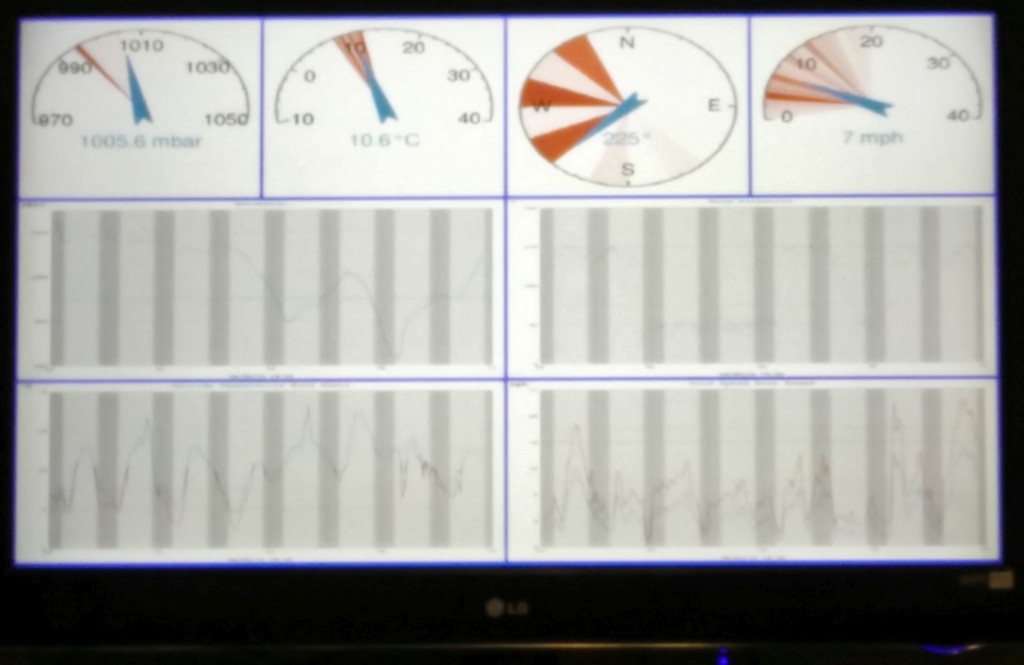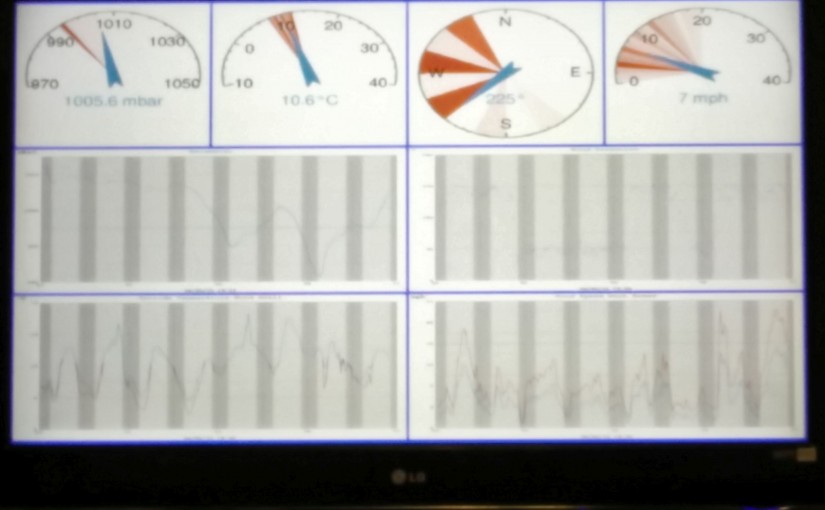I’ve been using wview with my WH1080 weather station for some time (actually 2 of them). My main setup has been using my server, and every now and again the WH1080 would seem to lock up and nothing could get data out of it. The solution was to drop it’s power, on reboot it would all start working again.
However wview also seemed to introduce lockups of it’s own and the only solution there was to reboot the server (not ideal). So when it came to setting up a second weather station (in a remote location) I needed something a bit more stable and started looking at alternatives. I was doing this on a Raspberry PI and found wview. After installing it sometime last year it seemed pretty stable (although the WH1080 still manages to lockup).
Back to my house and I’ve finally had enough of missing weather data. One thing I really liked with wview was the ability to pull the archive data if the weather station had been running when the machine hadn’t (providing the USB hadn’t locked up), I really recommend looking at wview if your starting out.
I’ve already covered setting up weewx on a Raspberry PI and I’m not going to post about my exact configuration here. Instead I’m going to share my Python code for displaying the various graphs and gauges straight to the TV. At the moment I have my weather PI connected to the TV via HDMI. This may change later and then I’ll have to adjust the code to pull the images to another pi before displaying them (I have a similar project for displaying webcams already).
So a few things before the code.
- It’s my first real attempt at using classes, so my code will be more than a little scattered.
- You need to have python, pygame, wview, (and for this exact code Bootstrap for wview but you could just change the file paths to the Standard guages and graphs), mysql and wview configured for mysql.
- I have this started using an init script (added below).
- This runs the python program as root, I need to find a way to run this as a normal user (but that will affect point 5&6).
- This program checks mysql is able to be connected to and restarts mysql of not.
- It also checks the freshness of the index.html file (not the best way but a quick way) to make sure wview is running keeping the files upto date. If not it reboot the PI, this causes the weather station to reboot so if the USB locks up the whole system resets fixing it.
So now onto the python code
#!/usr/bin/python
import os
import time
import pygame
import MySQLdb as mdb
import signal
import sys
imglocation = "/var/www/weewx/Bootstrap"
class pyscreen :
screen = None;
def __init__(self):
"Initializes a new pygame screen using the framebuffer"
disp_no = os.getenv("DISPLAY")
if disp_no:
print "I'm running under X display = {0}".format(disp_no)
# Check which framebuffer drivers are available.
drivers = ['fbcon', 'directfb', 'svgalib']
found = False
for driver in drivers:
# Make sure that SDL_VIDEODRIVER is set
if not os.getenv('SDL_VIDEODRIVER'):
os.putenv('SDL_VIDEODRIVER', driver)
try:
pygame.display.init()
except pygame.error:
print 'Driver: {0} failed.'.format(driver)
continue
found = True
break
if not found:
raise Exception('No suitable video driver found!')
size = (pygame.display.Info().current_w, pygame.display.Info().current_h)
print "Framebuffer size: %d x %d" % (size[0], size[1])
self.screen = pygame.display.set_mode(size, pygame.FULLSCREEN)
pygame.mouse.set_visible(False)
# Clear the screen to start
self.screen.fill((0, 0, 0))
# Initialise font support
pygame.font.init()
# Render the screen
pygame.display.update()
def __del__(self):
"Destructor to make sure pygame shuts down, etc."
def size(self):
size = (pygame.display.Info().current_w, pygame.display.Info().current_h)
return size
def fill(self, colour):
if self.screen.get_at((0,0)) != colour:
self.screen.fill((0, 0, 0))
self.screen.fill(colour)
pygame.display.update()
def image(self, img, locX, locY, sizX, sizY):
try:
if (( "week" not in img) and (os.stat(img).st_mtime > time.time() - 600)):
# 600 = 10 mins.
image = pygame.image.load(img)
image = pygame.transform.scale(image, (sizX, sizY))
self.screen.blit(image, (locX, locY))
elif(( "week" in img) and (os.stat(img).st_mtime > time.time() - 7200)):
# 7200 = 2 hours.
image = pygame.image.load(img)
image = pygame.transform.scale(image, (sizX, sizY))
self.screen.blit(image, (locX, locY))
else:
pygame.draw.rect(self.screen, (255, 0, 0), (locX, locY, sizX, sizY), 0)
except pygame.error, message:
pygame.draw.rect(self.screen, (255, 0, 0), (locX, locY, sizX, sizY), 0)
pygame.display.update()
def text_object(self, msg, font):
black = (0, 0, 0)
textSurface = font.render(msg, True, black)
return textSurface, textSurface.get_rect()
def error(self, msg):
largeText = pygame.font.Font('freesansbold.ttf', 115)
TextSurf, TextRect = screeny.text_object(msg, largeText)
size = screeny.size
TextRect.center = ((pygame.display.Info().current_w/2),(pygame.display.Info().current_h/2))
self.screen.blit(TextSurf, TextRect)
pygame.display.update()
class fileman:
global imglocation
def __init__(self):
"Init for fileman. Nothing to do atm."
def __del__(self):
"Destructor for fileman. Nothing to do again."
def total_files(self):
count=0
for file in os.listdir(imglocation):
if file.endswith(".png"):
count=count+1
return count
class sqly:
def __init__(self):
"do nothing"
def test(self):
try:
con = mdb.connect('localhost', 'weewx', 'weewx', 'weather')
cur = con.cursor()
cur.execute("SELECT VERSION()")
ver = cur.fetchone()
return 0
except mdb.Error, e:
return 1
finally:
"do nothing"
def restart(self):
#wait 30 secs and try the connection again.
time.sleep(30)
if not mysql_con.test():
try:
os.system("service mysql start")
except:
"do nothing"
def sigterm_handler(_signo, _stack_frame):
"When sysvinit send the TERM signal, cleanup before exiting"
print("[" + get_now() + "] received signal {}, exiting...".format(_signo))
sys.exit(0)
signal.signal(signal.SIGTERM, sigterm_handler)
def reboot():
"check if we've been reboot in the last 30 mins"
uptimef = open("/proc/uptime", "r")
uptimestr = uptimef.read()
uptimelst = uptimestr.split()
uptimef.close()
if float(uptimelst[0]) < 1800:
"We've reboot in the last 30 mins, ignoring"
else:
try:
os.system("reboot")
except:
"do nothing"
if __name__ == "__main__":
try:
screeny = pyscreen()
filey = fileman()
screeny.fill((0, 0, 255))
size = screeny.size()
border = 7
sizewquarter = ((size[0]-(border*5))/4)
sizehthird = ((size[1]-(border*4))/3)
print("Total files : %d" % (filey.total_files()))
while 1:
mysql_con = sqly()
if mysql_con.test():
screeny.fill((250, 0, 0))
screeny.error("Database Offline. Restarting!")
mysql_con.restart()
elif (os.stat("/var/www/weewx/Bootstrap/index.html").st_mtime < time.time() - 600):
screeny.fill((254, 0, 0))
screeny.error("NOT Updating. Reboot Imminent!")
reboot()
else:
screeny.fill((0, 0, 255))
screeny.image("/var/www/weewx/Bootstrap/barometerGauge.png", (border*1), (border*1), sizewquarter, sizehthird)
screeny.image("/var/www/weewx/Bootstrap/outTempGauge.png", ((border*2)+(sizewquarter*1)), (border*1), sizewquarter, sizehthird)
screeny.image("/var/www/weewx/Bootstrap/windDirGauge.png", ((border*3)+(sizewquarter*2)), (border*1), sizewquarter, sizehthird)
screeny.image("/var/www/weewx/Bootstrap/windSpeedGauge.png", ((border*4)+(sizewquarter*3)), (border*1), sizewquarter, sizehthird)
screeny.image("/var/www/weewx/Bootstrap/big_images/weekbarometer-Bootstrap.png", (border*1), ((border*2)+(sizehthird*1)), ((sizewquarter*2)+(border*1)), sizehthird)
screeny.image("/var/www/weewx/Bootstrap/big_images/weektempchill-Bootstrap.png", (border*1), ((border*3)+(sizehthird*2)), ((sizewquarter*2)+(border*1)), sizehthird)
screeny.image("/var/www/weewx/Bootstrap/big_images/weekwinddir-Bootstrap.png", ((border*3)+(sizewquarter*2)), ((border*2)+(sizehthird*1)), ((sizewquarter*2)+(border*1)), sizehthird)
screeny.image("/var/www/weewx/Bootstrap/big_images/weekwind-Bootstrap.png", ((border*3)+(sizewquarter*2)), ((border*3)+(sizehthird*2)), ((sizewquarter*2)+(border*1)), sizehthird)
time.sleep(1)
except KeyboardInterrupt:
"We've got an interupt"
and now the init.d code
#!/bin/sh
#
# init script for displayweewx
#
### BEGIN INIT INFO
# Provides: displayweewx
# Required-Start: $syslog $network
# Required-Stop: $syslog $network
# Default-Start: 2 3 4 5
# Default-Stop: 0 1 6
# Short-Description: init script to display weewx charts via HDMI output
# Description: The python script queries mysql and file ages, so does not rely on mysql as a backup way to kick it.
### END INIT INFO
PATH=/usr/local/sbin:/usr/local/bin:/usr/sbin:/usr/bin:/sbin:/bin
NAME=displayweewx
DAEMON=/root/displayweewx/main.py
DAEMONARGS=""
PIDFILE=/var/run/$NAME.pid
LOGFILE=/var/log/$NAME.log
. /lib/lsb/init-functions
test -f $DAEMON || exit 0
case "$1" in
start)
start-stop-daemon --start --background \
--pidfile $PIDFILE --make-pidfile --startas /bin/bash \
-- -c "exec stdbuf -oL -eL $DAEMON $DAEMONARGS > $LOGFILE 2>&1"
log_end_msg $?
;;
stop)
start-stop-daemon --stop --pidfile $PIDFILE
log_end_msg $?
rm -f $PIDFILE
;;
restart)
$0 stop
$0 start
;;
status)
start-stop-daemon --status --pidfile $PIDFILE
log_end_msg $?
;;
*)
echo "Usage: $0 {start|stop|restart|status}"
exit 2
;;
esac
exit 0
After all of this we get the following on the TV

